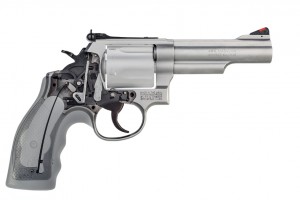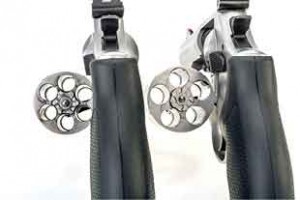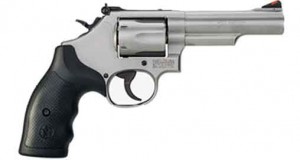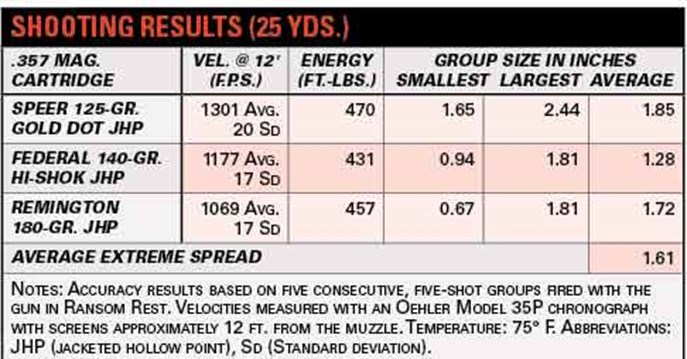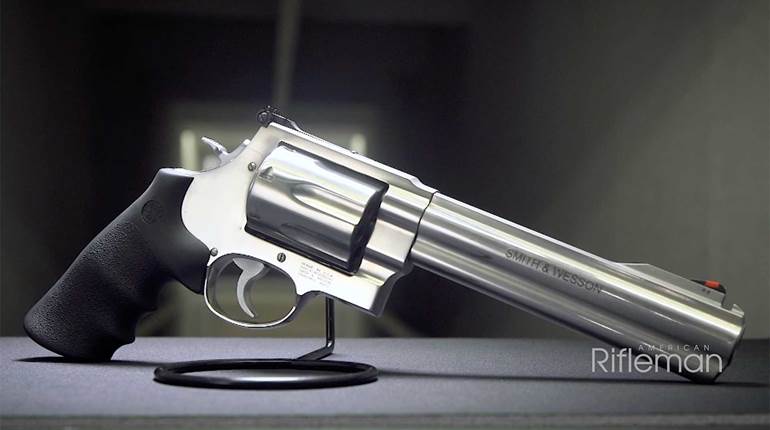
It was Mark Twain who once coined the phrase "... the report of my death was an exaggeration." That pithy observation might also fit the state of affairs with the traditional double-action/single-action revolver from Smith & Wesson-the Hand Ejector series. They have been making them up there in Springfield, Mass., since the 1890s, but their popularity has declined in the wake of the current enthusiasm for black plastic pistols. Through the decades of Hand Ejector production, there have been some great milestones-the Triple Lock of 1907, the service .45s of 1917, the first Magnum in 1935 and many more. Guns like those classics have been the visible manifestations of a sound design, but there are many, many little things improved slowly and almost invisibly. Things such as the hammer block safety of the '20s and the bolt block of the '80s show the maker's willingness to evolve.
Unquestionably, the revolver is no longer the daily companion of those who protect our citizens as that function is now served by some form of semi-automatic pistol. Despite attempts to build a powerful pistol for the sportsman, though, the big magnum revolver remains his best choice. It is in that large revolver for sportsman-as well as strong sales of small-frame hideout revolvers-that we see the logic of continuing revolver production and development. Smith & Wesson knows that, and the guns at hand are proof positive that it still has a trick or two up its sleeves. The two guns are an L-frame .44 Mag. called the Model 69 and a re-work of an enduring police classic designated the Model 66. It's really nice to see the new 66 as its predecessor was my issue sidearm for many years as a deputy sheriff. I will treat the updated Model 66 as a separate entity in an adjacent sidebar. Both revolvers come with 4¼" barrels to permit sales in Canada.
The right side of the Model 69's barrel reads ".44 MAGNUM" and "COMBAT MAGNUM" in two lines. The use of the combat terminology is an insight into why the Model 69 is what it is. In the '50s, when S&W was updating its catalog with a flurry of great new designs, it began to use the name Combat Masterpiece for a 4", K-frame, .38 Spl. intended for police service. At the urging of the late Bill Jordan, the company made a slightly heavier and stronger K-frame chambered for the .357 Mag. known as the Combat Magnum. Both models enjoyed great popularity. The image was that of a light and easily carried holster revolver with target grade features and the strength to manage the powerful and evolving ammunition of the post-World War II era. As that was happening, Smith also offered a large revolver on its N-frame and chambered it for a new magnum cartridge, the .44 Mag. The .44 Mag. was a brute of a handgun and really took off when adopted by a certain fictional San Francisco police detective named Harry Callahan, portrayed in film by Clint Eastwood. The gun and caliber were a resounding success. At the same time, the lighter and smaller Combat Magnum was doing even better in .357 Mag.
Eventually, .357 Mag. loads evolved toward lighter bullets and greater velocity, which began to challenge the longevity of the K-frame gun. By the late '70s, S&W came up with a fix for its medium-frame magnum situation. It was the Distinguished Combat Magnum, built on an all-new foundation designated the L-frame. Intermediate in size, between the smaller K-frame and larger N-frame, the new L-frame was beefed up in several critical areas (mostly the cylinder) to take the hottest loads available by Sporting Arms and Ammunition Manufacturers' Institute specifications.
It was, literally, a revolver sized and built for the .357 Mag. cartridge. The cops on the beat took to the new gun with gusto, but by the time the gun was widely distributed, police attention had shifted to the semi-automatic pistol. The L-frame .357s persist to date and have seen a number of interesting innovations, such as the use of a seven-shot cylinder in .357 Mag., a five-shot cylinder in .44 Spl. and even a few .40 S&W six shots (with moon clips). The L-frame is the all-purpose medium-size revolver. But sportsmen want more power for defense afield and even for some types of medium-game hunting. Until now, their best bet was the larger N-frame in .41 or .44 Mag. These are six-shot revolvers built on frames big enough to take the magnum recoil, but rather heavy for most shooters to carry. How about a five-shot .44 Mag. on the smaller and lighter L-frame? Would that be feasible or practical?
Well, yes and yes. This is what this story is all about-Smith & Wesson's all-new Model 69. It is a great new wheelgun that needs to be examined in detail. First, let's look at how the designers were able to build enough strength into the gun. The weak part of the system is the yoke that supports the cylinder, particularly at the instant of firing. The traditional Hand Ejector series had a center pin that ran through the ejector rod, locking the column of parts at the rear end of the cylinder, and into a lug under the barrel at the front. It works, but is not really strong enough for the five-shot .44 Mag. S&W engineers dispensed with the center pin running through the ejector rod in favor of a solid rod. The forward-most locking point is now right at the yoke. There is a sturdy ball bearing in the yoke, powered by a strong spring, and the ball indexes into a V-shape notch in the side of the barrel underlug. That change simplifies and strengthens the cylinder mechanism. The company also departed from the traditional one-piece barrel in favor of the two-piece system developed for several smaller revolvers. While there are a few other upgrades, this is the heart of the system and the means of answering the feasibility question-the answer to which is yes.
How about practical? Well, .44s kick, and we all know it. A carry-size N-frame six-shot .44 Mag. with 4" barrel weighs 44.1 ozs. while an even easier carrying L-frame five-shot .44 Mag. with 4¼" barrel weighs 37.2 ozs. The latter figure is 6.9 ozs. less than the former. Therefore, a Model 69 is less than a half-pound lighter than a Model 629. That makes it roughly the same as a Colt M1911, and you may recall Americans have carried those pistols all over the globe. Certainly, the lesser weight is easier to pack, but it also kicks more when you fire it. The question is whether the added recoil is bad enough to be a pre-occupying factor. I can only put this in perspective subjectively-it is severe, but bearable. I used to shoot long-barreled .44s all afternoon, but I wouldn't want to do that with a 69. If you want to enhance the enjoyment of shooting your Model 69, I would strongly advise a set of Trooper stocks from Herrett's. They are the best things I have ever used when it comes to managing heavy recoil in a double-action revolver.
It is obvious that S&W gave the 69 a classic appearance. The shroud portion of the two-piece barrel is shaped like the heavy, short-underlugged barrels of the mid-1950s. Stocks are finger-grooved rubber that the purists will not like. But I am pleased to see the topstrap of the revolver finished like the earlier guns, with the lateral serrations running the complete distance between the sights. It has that attractive dull sheen of stainless steel and traditional red ramp and white outline sighting system. It is a very nice gun that shoots as well as it looks.
At the range, I tried three different loads with results as tabulated nearby. The sample revolver worked through five, five-shot groups with all three. When all the brass was in the old bleach jug and groups measured, the overall average was 1.76"-excellent. I did not shoot in double-action mode more than a few shots, but the trigger action was very heavy. So was the single-action trigger, but it was crisp.
Although time must pass and many more rounds must be in the butts before we know for sure, it appears that the Model 69 is another milestone. I am assured S&W did all its stress testing, and the new system holds up well. It promises to be one of those guns that begets a string of variations in the months and years to come. It would easily be a better choice for the outdoor types who need powerful handguns as they go about their work in the wild. Dirty Harry must have retired from SFPD by now, but it would be just the gun for him, too.
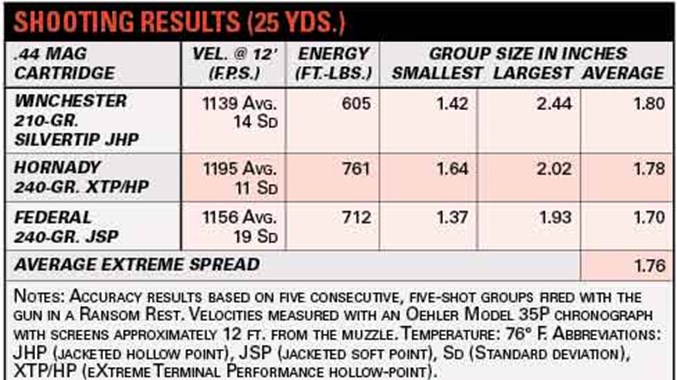
Smith & Wesson Model 69
Manufacturer: Smith & Wesson, 2100 Roosevelt Ave, Springfield, MA 01104; (800) 331 0852;
smith-wesson.com
Caliber: .44 Mag. (.44 Spl.)
Action Type: double-action/single-action center-fire revolver
Frame: stainless steel
Barrel: two-piece, 4¼"
Rifling: 1:18¾"
Cylinder Capacity: five rounds
Sights: adjustable rear with white outline; red ramp front
Trigger: double-action 10-lb., 7-oz. pull; single-action 3-lb., 6-oz. pull
Overall Length: 9.75"
Width: 1.57"
Height: 5.58"
Weight: 37.2 ozs.
Accessories: lockable hard case, cable lock, manual
Suggested Retail Price: $849
A Classic Updated: S&W's Model 66 Redux
When I received that first Model 66 back in the '70s, I was one happy camper. It was a durable, rust-resistant, accurate service revolver that I carried for years as a patrolman. Not surprisingly, I was eager to see what S&W was going to do with its much-heralded upgrade of the original. Outwardly, there is not much change, except for the shape of the receiver to accommodate the key lock. But there are several interior changes that are important. First, take everything I said about the Model 69 and apply it to the Model 66. On the medium K-frame, the cylinder is a six-shot-no change there. But all the original K-frame .38s and .357s had a design flaw in the shape of the barrel shank. It had a flat spot at the 6 o'clock point, necessary to allow the yoke to swing into place. If the gun didn't like the high-pressure ammunition you were feeding it, that was usually where it failed. Indeed, that is what pushed the L-frames into production.
In the interests of putting an end to this K-frame problem, S&W re-designed the K-frame to get a slightly larger revolver with more metal at critical points. The size difference is almost unnoticeable, but the gun is a little larger, particularly in height. It has no effect on performance. When I put the new 66 on paper, I was pleasantly surprised. I fired the American Rifleman protocol of five consecutive, five-shot groups with each of three different loads. That's 15 groups (75 rounds). Those groups averaged 1.61", with two groups less than an inch. That is excellent accuracy for a revolver of any era, new or old.
Smith & Wesson Model 66
Manufacturer: Smith & Wesson, 2100 Roosevelt Ave., Springfield, MA 01104;(800) 331-0852
smith-wesson.com
Caliber: .357 Mag. (.38 Spl.)
Action Type: double-action/single-action, center-fire revolver
Frame: stainless steel
Barrel: 4¼"Rifling: 1:18¾" RH twist
Cylinder capacity: six rounds
Sights: adjustable rear with white outline, red ramp front
Trigger: double-action 10-lb., 9-oz. pull; single-action 3-lb., 4-oz. pull
Overall Length: 9.69"
Width: 1.42"
Height: 5.25"Weight: 36.6 ozs.
Accessories: lockable hard case, cable lock, manual
MSRP: $849
